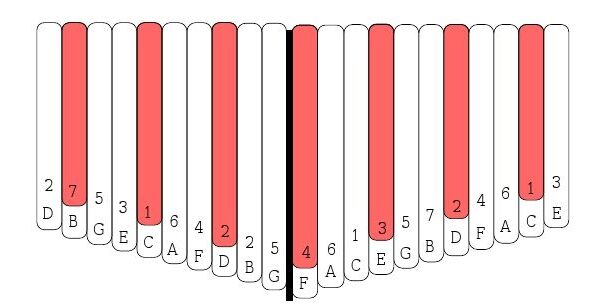
Use of this website constitutes acceptance of the Privacy Policy and User Agreement. Copyright © 2020 Kalimba Magic. All Rights Reserved.
Several Chinese companies have been making pretty good 17-note kalimbas lately. They are roughly copies of the Hugh Tracey Treble Kalimba, but are tuned to the key of C. I paint my 17-Note Kalimbas in C differently than suggested by the Chinese, so that the kalimba is consistent with my library of tablature.
More recently, there have been some 21-Note Kalimbas made. This post shows you how at least some of these kalimbas are tuned, and how you might paint them so that you can use Kalimba Magic materials to learn to play.
How to Tune and Paint a 21-Note Kalimba to use Kalimba magic materials.

The key thing to realize is that the low note of the 21-Note Kalimba (F) is not the root note (C).
Of course, I am glossing over the fact that I don’t (yet) have any instructional materials created specifically for the 21-Note kalimba.
There will be suggestions of different ways to paint the 21-Note Kalimba… however, if you color the tines as indicated here, you will be able to draw upon a wide body of materials for the 17-Note Kalimba in C.
The 21-Note Kalimba reads “17-Note in C” materials by ignoring the bottom four tines.
The 21-Note Kalimba has four extra low notes for harmonies.
You can start out by pretending that you only have 17 notes – for example, cut a sticky note to be wide enough to just cover the central four tines. When covered with the sticky note, the new lowest note will be “C” to the right of center, and then “D” on the left. The sticky note is like training wheels – remove when no longer helpful.
You are now all set up to use any of the books or instructional downloads available for the 17-Note Kalimba in C.
But, how will you use the lower notes of your 21-Note kalimba? Here are three ideas:


Sign up for our newsletter and free resources with your email address:
We pinky promise not to spam you and to only send good stuff.
 Assist Paul Tracey Rebuild His House in Pacific Palisades
Assist Paul Tracey Rebuild His House in Pacific Palisades 8-Note Spiral Kalimba Turned into a Student Karimba
8-Note Spiral Kalimba Turned into a Student Karimba Seek to Infuse Your Musical Moments With Beauty and Magic
Seek to Infuse Your Musical Moments With Beauty and MagicUse of this website constitutes acceptance of the Privacy Policy and User Agreement. Copyright © 2020 Kalimba Magic. All Rights Reserved.